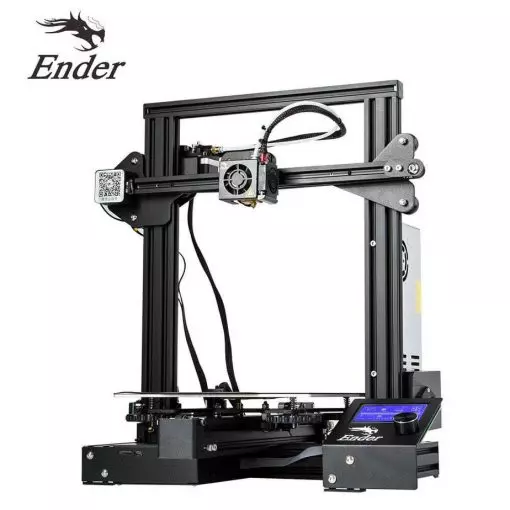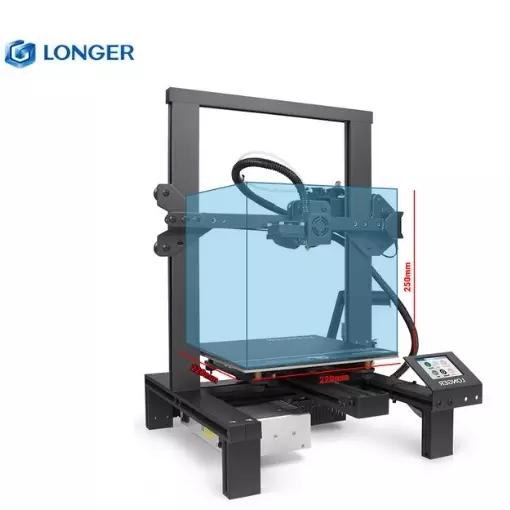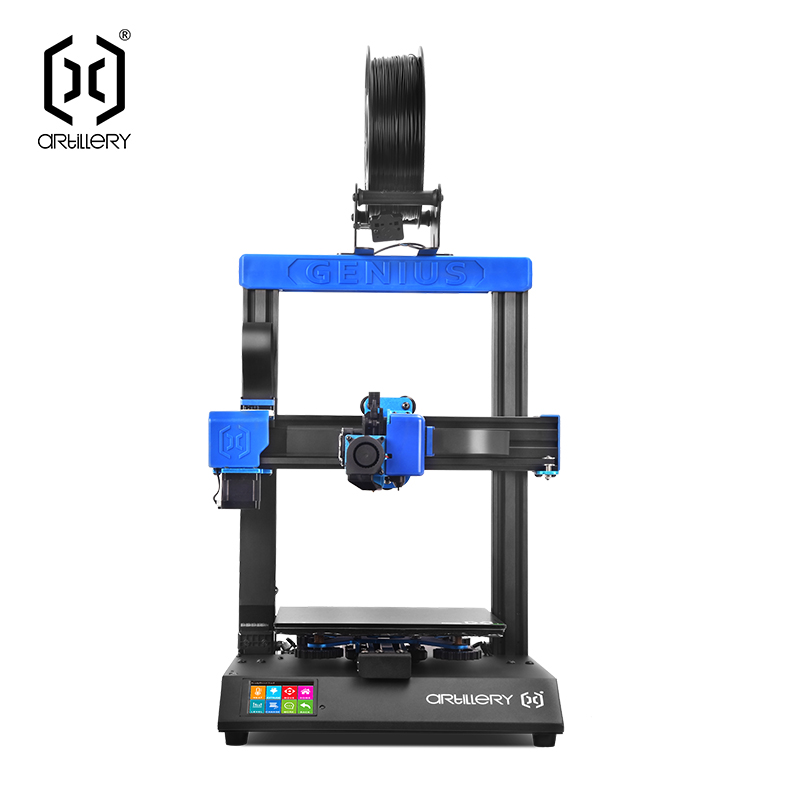Compare Ender 3 vs LK4 vs Genius Pro
Comparison between the best 3D printers
Choose the best 3D printer at the best price. The cheapest 3D printers are here.
Buy a 3D printer here with 3D Fila.
 |
 |
 |
|
| Model | Ender 3[BUY Ender 3] |
LK4 |
Genius Pro[BUY Genius Pro] |
| Printing Material | Filament | Filament | Filament |
| Estimated price | $210,00 | $200,00 | $309,00 |
| Fabricante | Creality 3D | Longer 3D | Artillery |
| Release Year | 2018 | 2019 | 2022 |
| Print Volume [mm] | 220x220x250 | 220x220x250 | 220x220x250 |
| Printer Size [mm] | 440x440x465 | 402x425x505 | 430x390x590 |
| Weight [kg] | 6,62 | 7,8 | 9,6 |
| Power Loss Recovery | NO | YES | YES |
| Enclosed printer | NO | NO | NO |
| Bed Leveling | Manual | Manual com Assistência | Automatic |
| Filament End Sensor | NO | YES | YES |
| Bed type | Heated | Heated | Heated |
| Power supply system | Bowden | Bowden | Direct Drive |
| Standard nozzle | 0,4 | 0,4 | 0,4 |
| Maximum Nozzle Temperature [°C] | 255 | 250 | 240 |
| Maximum Bed Temperature [°C] | 110 | 100 | 120 |
| Maximum printing speed [mm/s] | 180 | 120 | 150 |
| Filament holder | YES | YES | YES |
| Camera for supervision | NO | NO | NO |
| Recommended filaments | PLA, TPU, ABS, PETG | PLA, TPU, ABS, PETG | PLA, PETG, Tritan, Flex, ABS |
| Recommended slicers | Cura, Simplify, Slic3r | Cura, Simplify, Slic3r | Cura, Simplify, Slic3r, IdeaMaker |
| Maximum Resolution [mm] | 0,1 | 0,1 | 0,1 |
| Processor | 8 bits | 8 bits | Ruby 32bit |
| Display | Mono | Touchscreen TFT 2,8'' | Touchscreen TFT 3,5'' |
| Power Supply | 24V / 270W | 12V / 360W | |
| Connectivity | SD / USB | SD / USB | SD / USB |
| Operating systems | Windows, Mac, Linux | Windows, Mac, Linux | Windows, Mac, Linux |
| Date of registration in the system | 2021-04-13 | 2021-04-15 | 2022-11-07 |
| Release date | 2018 | 2019 | 2022 |
| Extra features | The Ender 3 V1 is a DIY assembly 3D printer, a sales leader since 2017, standing out for its cost-benefit. With a wide printing capacity, it has a CNC machined structure for precision and stability. It offers high-precision prints with low noise, thanks to its innovative V-profile and pulleys. It has a self-adhesive magnetic platform for easy removal of models and excellent adhesion. The Ender 3 heats up quickly, reaching 100°C in 5 minutes, ideal for agile prints. It includes protection against power failures, allowing you to resume printing after interruptions, saving time and material. | The Longer LK4 is a versatile 3D printer capable of working with a wide range of filaments, such as PLA, ABS, TPU, copper, wood and carbon fiber, thanks to its 0.4mm nozzle and heated bed up to 110°C. With a printing accuracy of between 0.05-0.4mm, it stands out for its solid construction with an aluminum frame, weighing around 7kg, and a robust 24V and 15A power supply. The kit includes an Allen key, a 7/10 key, a microSD card with USB adapter, a spatula, cable ties, a power cable, 5m of filament and a spare filament end sensor. Assembly is simplified, with around 90% of the equipment pre-assembled, and detailed instructions assist in the process. Special features include print recovery after power failure, a filament end sensor, a super-adhesive printing surface and an intuitive color touchscreen display. The design features smooth profiles for easy assembly, and the position of the filament holder optimizes the filament path to the extruder. The LK4 is a solid choice for 3D printing enthusiasts looking for quality and versatility. | The Artillery Genius Pro is a standout 3D printer with a fast-heating AC tempered glass print bed and a sleek design with a black aluminum base and blue accents. It features a Titan-style direct extruder and a 32-bit Ruby mainboard. Despite its advanced feature set, it struggles to maintain print quality, requiring frequent adjustments and calibrations, and its glued glass bed makes cleaning and replacement difficult. |
| Support for multiple colors and materials (AMS and CFS) | NO | NO | NO |
Notes * |
|||
| Cost-benefit | 6 / 10 | 7 / 10 | 7 / 10 |
| Hardware | 0.5 / 10 | 2 / 10 | 2.8 / 10 |
| Screen | . | . | . |
| Print volume | 3 / 10 | 3 / 10 | 3 / 10 |
| Performance | 1 / 10 | 1 / 10 | 1 / 10 |
| [BUY Ender 3] | [BUY Genius Pro] |
Conclusion |
| In comparing the three 3D printers—Ender 3, Longer LK4, and Artillery Genius Pro—several key factors emerge that can guide a potential buyer in selecting the best fit for their needs. The **Ender 3** stands out as a cost-effective option, offering a solid balance of features for its price. Though it requires manual bed leveling, it compensates with a quick heat-up time and robust construction, making it ideal for newcomers and those looking for reliable performance without breaking the bank. Its lack of power loss recovery can be a downside for some users, yet its strong reputation for print quality and upgradeability makes it a popular choice among hobbyists. The **Longer LK4** offers some additional features that enhance usability, such as a filament end sensor and automatic bed leveling assistance. Despite its slightly higher price point, the LK4 strikes a nice balance between affordability and enhanced functionality, making it suitable for users who value ease of use and versatility. It has a solid build quality and can handle a variety of filament types, further broadening its appeal to different printing needs. On the other hand, the **Artillery Genius Pro**, while being the most expensive of the three, includes a direct drive extruder and a more advanced 32-bit processor. These features promise improved print quality and versatility with filament options. However, its issues with maintaining print quality and the design of its bed may deter potential buyers who seek ease of maintenance and reliable performance without extra adjustments. Ultimately, each printer has its strengths and weaknesses. The **Ender 3** is preferable for budget-conscious users who are willing to engage in manual setup and adjustments. The **Longer LK4** is better suited for those who appreciate enhanced user-friendly features at a slightly higher price. Meanwhile, users willing to invest in the **Artillery Genius Pro** may find value in its advanced capabilities, but they should be prepared to handle additional calibration challenges. In conclusion, prioritizing needs such as budget, user-friendliness, and specific printing capabilities will help guide new buyers in making the best choice among these three printers. |

